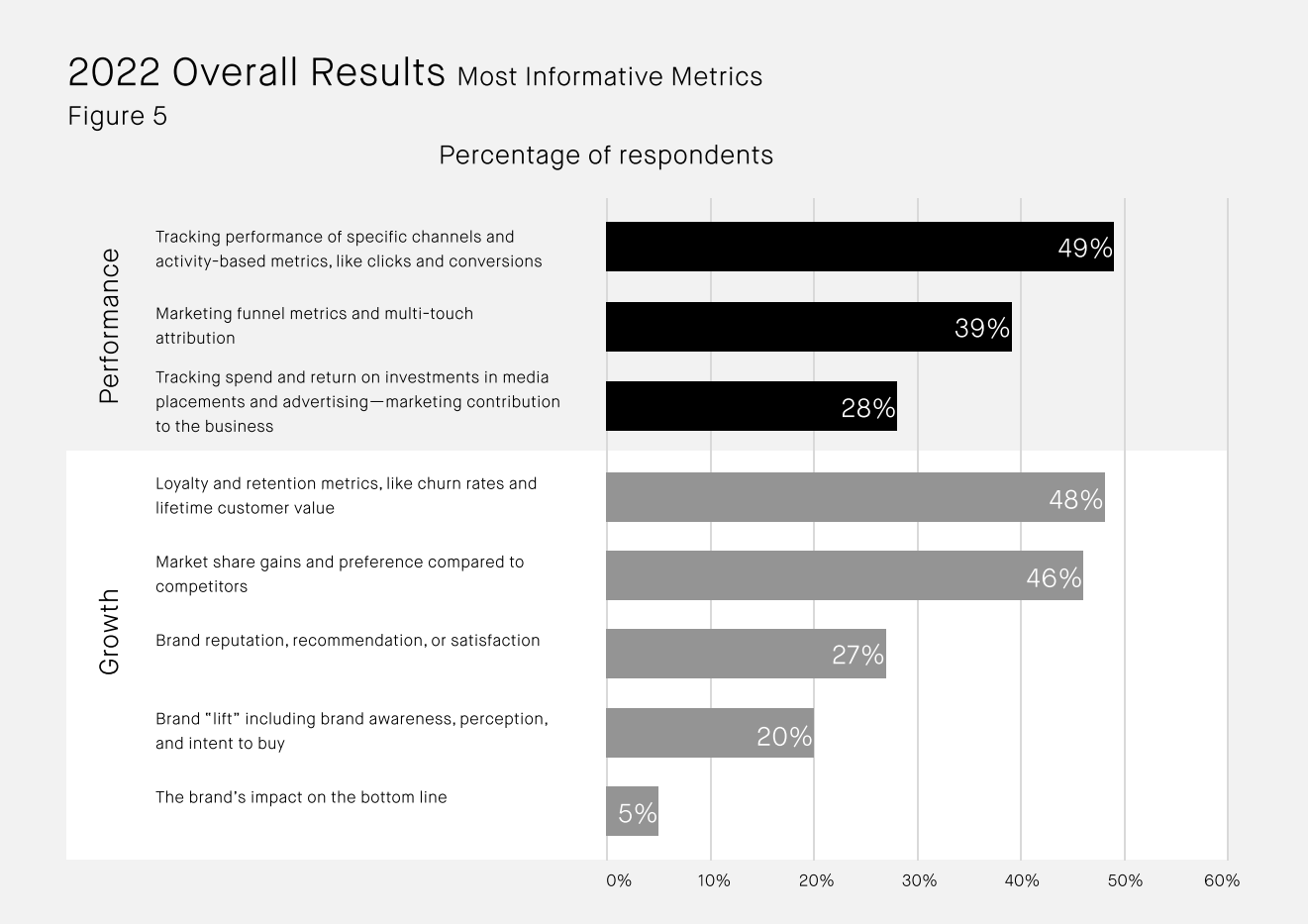Metrics matter and the key to crafting an unshakable marketing strategy relies heavily on the ability to leverage data and measure success. For this reason, DEPT® created a calculation to best assess and measure the level of growth marketing maturity within a company. This calculation is known as the Growth Marketing Maturity Index™, or GMMI™, for short.
The GMMI™ is a proprietary tool that determines how well companies have integrated growth marketing into their broader operating models, how effective they are at executing growth initiatives, and their ability to adapt to disruptive technologies, market trends, and competitors.
The assessment tool measures six key “pillars” that collectively contribute to a growth marketing mindset. These pillars reveal how a brand has envisioned and invested in growth marketing and show how well a brand has implemented their growth marketing practices into the whole organization.
To be a successful growth marketer, it’s important to closely examine these six pillars of influence and understand how they fit within your overall marketing strategy to drive long-term sustainable growth.
Pillar #1: strategic approach
Marketing teams need to be aligned on a clear vision and a long-term strategic plan to set and prioritize actionable goals and drive long-term objectives that tie back to the company’s broader vision.
Success in this pillar is defined by how well a brand has proactively created specific marketing goals that can be measured to show progress and results that impact the overall business’ bottom line. Given the nature of the ever-changing marketing landscape, and that unforeseen factors can always arise, this strategic approach should constantly be evolving and re-evaluated over time.
Pillar #2: data management and activation
Data management and activation relates to how a marketing team collects, tracks, stores, and analyzes customers’ data in real-time to gain insights and improve results throughout the marketing funnel and the entire customer journey. These insights and data allow marketers to create a more informed view of the customer, which allows for a more personalized and enjoyable experience.
Successful growth marketers are data-driven and know how to utilize and leverage data to gain insights into their current capabilities and activities. They also know that data helps them define and measure progress and optimize accordingly. Brands should be tracking both performance AND growth metrics if they expect to see results from their efforts:
- Performance metrics are based on intent and conversion and are related specifically to a singular channel. A few examples of performance metrics include webpage visits, cost per acquisition, open rates, and click-through rates.
- Growth metrics take a much broader, more high-level look at your brand’s performance, especially in terms of retention and revenue. A few examples of growth metrics include churn rates, lifetime customer value, brand reputation, and market share gains.
The chart in Figure 5 shows an example of performance and growth metrics in DEPT®’s 2022 Growth Marketing Report. This chart also displays the overall results from the report:

Success in this pillar is contingent on how effective a brand is at proactively tracking and monitoring key performance indicators (KPIs) to various elements of a marketing strategy and especially on metrics that are connected to the overall health of the company. This includes everything from the return on investment of a campaign to customer churn and lifetime value.
Pillar #3: management buy-in
A common challenge CMOs often face is justifying the impact of marketing efforts and spending, which typically leads to a greater focus on the short-term rather than long-term financial impact.
Growth marketing is a longer-term approach that places a heavy emphasis on attracting and retaining customers, customer engagement, and creating value at every step of the customer journey.
This full-funnel marketing approach begins with awareness and focuses on addressable audiences (upper-funnel), and then engages and educates consumers (middle-funnel), until finally converting leads into customers (bottom-funnel). On the other hand, performance marketing almost exclusively focuses on short-term performance (bottom of the funnel) and “quick wins” to stay profitable.
Success in this pillar involves collaborating with executives to craft a robust, sustainable strategy that aligns the budget to strategic brand goals that will positively impact the bottom line.
Marketers need the support of the C-suite, as they play a major role in making budget allocation decisions and resource management. Without their backing, it becomes more difficult to hire the right people for a strong in-house team or to outsource work to high-quality digital marketing agencies.
At the end of the day, marketers need to prove the value of full-funnel marketing and show that this approach best delivers strategic direction and growth in order to gain management buy-in.
Pillar #4: in-house resources
Behind every successful marketing strategy is a high-performing marketing team. But of course, great teams aren’t just assembled overnight. The best marketing teams are aligned on specific goals, are clear on each individual’s expectations, and understand the brand’s overall strategy and how they contribute.
To be successful in this pillar–and to build an effective in-house marketing team–consider the following:
- Ideally, you will have at least one individual dedicated to each specialty (such as a paid media specialist or data scientist).
- Place a heavy focus on professional development and nurture a top-to-bottom learning culture.
- Set clear objectives and make transparency a priority for more informed decision-making.
- Focus on effective collaboration and communication (remove all silos) so that every person on the team knows what goals they are working towards and why it’s crucial to the company’s overall strategy.
Pillar #5: agency support
These days, it’s extremely common for brands to work with agencies for expertise in areas that they may not cover in-house or don’t have the resources to support in-house. It’s also typical to see many brands work with multiple agencies to execute projects or campaigns.
The potential pitfall of a multi-agency strategy (especially if there is not a single point of contact within your company) is that it tends to establish divisions between teams that can:
- prevent the right information from being shared.
- form data silos that can lead to less informed decisions.
- create a disjointed customer journey.
- slow down your growth potential.
- hinder your ability to analyze and integrate campaign data.
Brands that see the most success in this pillar are those that have a single agency on retainer, rather than managing multiple agency relationships. It’s more likely that a single-agency model will be more aligned with your brand’s strategy and goals, and more familiar with the ins and outs of your brand and its history and progression over time.
Using one trusted and established partner will also ensure that your data program is consolidated so that all insights can be tracked and measured within the same system and toward the same goals.
Pillar #6: integrated customer experience
The savviest companies understand that consumers expect a seamless experience and touchpoints across various channels that allow for clear, consistent communication. Creating a highly personalized user experience and meaningful interactions is what builds trust, engagement, and loyalty with customers for years to come. The goal is to create life-long customers and brand advocates that will ultimately help grow and promote your brand.
Success in this pillar depends on how well a marketing team has optimized its strategy, specific marketing activities, and investments to create meaningful and consistent experiences across each stage of the buying journey and how efficiently they are able to meet their customer’s needs across the full marketing funnel.
Closing thoughts
There is no one-size-fits-all approach when it comes to brands. Every brand today has its own unique set of strengths and weaknesses, industry challenges, and objectives. Each of these pillars serves as a distinct characteristic of a brand’s approach to marketing, and understanding each of them is the first step toward understanding how advanced a brand is in its growth marketing journey.
Think that your brand could benefit from taking the GMMI™? Get in touch with one of DEPT®’s strategists to take our Growth Marketing Survey and gain a better understanding of how mature your growth marketing practice is.
Learn more about our growth services.
Explore
Questions?
Content Communications Specialist


